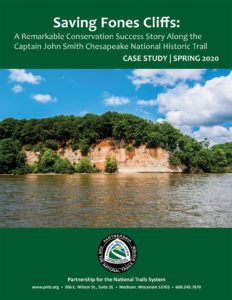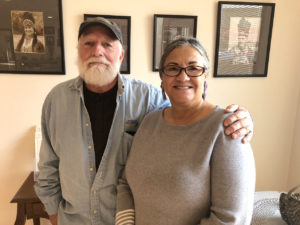By Don Owen, Partnership for the National Trails System
 The Partnership for the National Trails System (PNTS) has published its second case study about trail land protection efforts as part of a collaborative agreement with the U.S. Department of Transportation Federal Highway Administration.
The Partnership for the National Trails System (PNTS) has published its second case study about trail land protection efforts as part of a collaborative agreement with the U.S. Department of Transportation Federal Highway Administration.
“Saving Fones Cliffs: A Remarkable Conservation Success Story along the Captain John Smith Chesapeake National Historic Trail,” relays the 15-year sustained effort by conservation organizations to acquire Fones Cliffs in eastern Virginia in 2018. The following year, The Conservation Fund conveyed the property to the U.S. Fish and Wildlife Service for inclusion in the Rappahannock River National Wildlife Refuge.
Screech owls. Great blue herons. Bald eagles. A great expanse of fresh water, flowing into the tidal reaches of the Chesapeake Bay. Near-vertical cliffs, high above a river named for “the people who live where the water ebbs and flows,” dropping down to wetlands and marshlands along the river’s edge. A place of natural beauty, a place of reverence, a place where Native American and European cultures and history collided more than 400 years ago.
In 1608, as Captain John Smith and his crew sailed and rowed their shallop up the Rappahannock River, Rappahannock Tribe warriors gathered on Fones Cliffs high above the river to ambush him.
The cliffs, located in the heart of the ancestral home of the Rappahannock Tribe in eastern Virginia, are a key feature along the Captain John Smith National Historic Trail. The landscape also is home to one of the largest concentrations of bald eagles in the continental United States.

Photo Credit: Don Owen
Joe McCauley with the Chesapeake Conservancy and Rappahannock Tribal Chief Anne Richardson are featured in the Partnership’s newest case study.
The conservation of Fones Cliffs represents a huge “win” for the Rappahannock Tribe, the Chesapeake Bay, the Rappahannock Land Protection Partnership, the U.S. Fish and Wildlife Service’s Rappahannock River Valley National Wildlife Refuge, the Commonwealth of Virginia, and the Captain John Smith Chesapeake National Historic Trail. The convergence of these interests provided the momentum that carried the project from the early planning stages to the finish line.
The Rappahannock Land Protection Partnership served to promote collaboration among conservation organizations and agencies that otherwise might be in competition. The Federal government’s Collaborative Landscape Planning Program allowed the Partnership for the National Trails System and the Chesapeake Conservancy to advocate for Federal funding to protect Fones Cliffs as well.
In 2018, after 15 years of sustained effort by many conservation organizations, The Conservation Fund (TCF) was able to close the deal and acquire Fones Cliffs. The following year, TCF conveyed the property to the U.S. Fish and Wildlife Service for inclusion in the Rappahannock River National Wildlife Refuge.
The Fish and Wildlife Service plans to expand opportunities for hiking, birdwatching, and other wildlife-dependent recreation at Fones Cliffs in the near future. More importantly, though, for members of the Rappahannock Tribe, the property allows the tribal members to reconnect with their history. As Rappahannock Tribal Chief Richardson said, “Now, we can walk the land of our ancestors. We can feel the spirit of the people that lived here, worked here, and worshiped here. This land is sacred to our tribe. Thanks to all the partners who understand how essential land preservation is to our very existence.”
Click here to read the full story of how Fones Cliffs was conserved.
Unless otherwise indicated, all material in Pathways Across America is public domain. All views expressed herein are perspectives of individuals working on behalf of the National Trails System and do not necessarily represent the viewpoint of the Federal agencies.